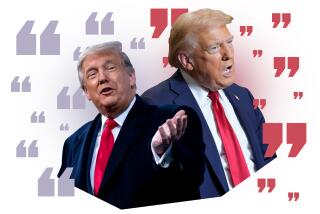A week that illustrated why coverage of Trump is mostly negative
Reporting from Washington — This week, the nonpartisan Pew Research Center released a study showing that news coverage of President Trump’s first 100 days in office had been, on average, far more negative than coverage of the previous three presidents.
Trump supporters, including White House Press Secretary Sarah Huckabee Sanders, seized on the study as evidence that the press treats Trump unfairly — an assessment that the study itself did not make.
The rest of the week’s events provided a perfect example of what’s wrong with any equation of “negative” with “unfair.” The study analyzed the language used in news articles. Stories about successes and accomplishments get scored as positive; stories about failures, dissension and misstatements add to the negative count. Coverage of Trump looks negative because, as this week showed, a lot of negative things happen.
Good afternoon, I’m David Lauter, Washington bureau chief. Welcome to the Friday edition of our Essential Politics newsletter, in which we look at the events of the week in Washington and elsewhere in national politics and highlight some particularly insightful stories.
SECRETARY OF STATE SEES A MORON
Amid all the news of the week, one event epitomized the state of the Trump administration — Secretary of State Rex Tillerson’s news conference Wednesday in which he denied he was planning to resign, pledged his fealty to Trump, but conspicuously did not deny he had referred to the president earlier this year as a “moron.”
The remark, first reported by NBC News, set off a furor in the White House when Trump learned of it Wednesday morning. Trump’s characteristic response was to rage at his aides and denounce NBC in a Twitter message: “NBC news is #FakeNews and more dishonest than even CNN. They are a disgrace to good reporting. No wonder their news ratings are way down!” he declared, inaccurately since NBC’s news ratings have been strong this year.
As Trump flew to Las Vegas, Chief of Staff John Kelly stayed behind, reportedly huddling with Tillerson and others to craft the response that the secretary of State delivered a few hours later.
On Capitol Hill, meanwhile, Tillerson’s backers defended him.
Senate Foreign Relations Committee chair Sen. Bob Corker (R-Tenn.), who last week announced that he will not run for another term, praised Tillerson, telling reporters that the secretary of State, Kelly and Defense Secretary James N. Mattis, “help separate our country from chaos.”
He declined to say who he had in mind as a generator of chaos, but he didn’t need to. In August, Corker publicly said the “the president has not yet been able to demonstrate the stability, nor some of the competence, that he needs,” and he’s stood by those words since.
The incident put into one package much that has characterized Trump’s tenure so far: internal dissension, public questioning of the president’s competence, an emphasis on personality over policy, and all of it involving administration officials and fellow Republicans, with Democrats playing the role of gleeful bystanders.
WHITHER THE IRAN DEAL?
Not that an emphasis on policy would necessarily be more positive for the administration.
The biggest, immediate foreign policy issue on the agenda this month involves Iran and the nuclear deal that was one of President Obama’s signature — and most controversial — achievements. Trump has repeatedly denounced the deal, but this week, some of his top national security aides voiced support for continued U.S. adherence to it, as Tracy Wilkinson, Bill Hennigan and Brian Bennett reported. Both Mattis and Gen. Joseph F. Dunford Jr., chairman of the Joint Chiefs of Staff, told Congress that maintaining the deal was in the national interest.
Trump is determined not to continue certifying that Iran is in compliance with the deal, even though administration officials concede that the Iranians have, in fact, complied with its terms. Next week, he’s expected to deliver a speech in which he’ll announce that he’s not going to issue another certification.
That will kick the issue over to Congress, which could reimpose sanctions on Iran. Doing that would nullify the deal, which includes five other countries, and allow Tehran to restart its nuclear weapons program free of restraints. More likely, Congress will debate the issue and find a way for Republican opponents of the deal to demonstrate their unhappiness without doing anything substantive.
TAX CUT PLAN ALREADY SHRINKING
A renewed debate on Iran might not end up changing much on the nuclear deal, but it will eat up time, especially in the Senate. And that could interfere with another administration priority: quick passage of a tax cut. If so, it would fit a pattern of the administration creating obstacles to achieving its goals.
Already, as Lisa Mascaro and Jim Puzzanghera reported, Republicans have been backing away from eliminating the deduction for state and local taxes, which was the biggest revenue raiser in the tax bill — a key way to pay for tax cuts without exploding the deficit. Wiping out the deduction would raise taxes for many upper-middle-class voters in states like New York, New Jersey, California and Pennsylvania. Those are mostly blue states, of course, but they have lots of Republican representatives in the House whose votes the tax bill will need.
Republican leaders admit the bill as currently written would increase the deficit, at least in the short run, as Mascaro wrote. So far, most of them seem to be willing to accept that, despite years of railing against red ink. But there are still some serious deficit hawks in the Republican caucus, and there’s a limit on how much of a deficit expansion they’ll accept.
That tension is just one of the reasons a tax bill could end up suffering the same fate as repeal of Obamacare — something Republicans agree on in theory, but have trouble gaining votes for in practice.
RUSSIA INVESTIGATION NOT GOING AWAY
Trump routinely cries “hoax” over allegations that people associated with his campaign colluded with Russia. But in a news conference this week called to update the public on the progress of their investigation, the leaders of the Senate Intelligence Committee, Sen. Richard Burr (R-N.C.) and Sen. Mark Warner (D-Va.), made clear they don’t share that view. As David Cloud wrote, the two senators said that after interviewing 100 witnesses and plowing through more than 100,000 documents, the Senate panel still has a lot to investigate.
FREQUENT FLIERS
Last Friday, Health Secretary Tom Price resigned after Trump publicly expressed unhappiness with news reports about his use of expensive, private charter flights for routine travel.
This week, the attention to the travel habits of Trump’s Cabinet members continued: The Treasury inspector general issued a report saying that Treasury Secretary Steven Mnuchin used military planes without adequate justification. The flights were legal, but cost the taxpayers about $800,000, the report found. And Interior Secretary Ryan Zinke is under investigation by his department’s inspector general for his taxpayer-funded flights.
FIGHTS ON THE ENVIRONMENT, CONSUMER PROTECTION AND CIVIL RIGHTS
The White House’s effort to roll back environmental rules continues to encounter trouble in court. As Evan Halper wrote, an administration order to ignore climate costs when considering major projects has generated a judicial backlash. And, separately, a federal judge ordered the administration to enforce new restrictions on methane emissions that Trump officials wanted to delay.
Halper also wrote about accusations by senior civil servants who charge that Trump is forcing out workers with expertise on climate change and the environment.
And another administration appointee is headed for a confirmation fight. At a Senate hearing on his nomination, William Wehrum, Trump’s pick to head the Environmental Protection Agency’s air pollution branch, wouldn’t pledge to allow California to continue setting its own air pollution standards.
The one regulatory agency that Trump has not yet been able to bring under his control is the Consumer Financial Protection Bureau, whose chief, Richard Cordray, has a term thatdoesn’t expire until midway through next year. This week, the bureau cracked down on payday lenders with new regulations, Jim Puzzanghera reported. Republican leaders in the House vowed to reverse the rules, but they may not have the votes.
At the Justice Department, Atty. Gen. Jeff Sessions continues to erase Obama-era rules. This week, Joe Tanfani wrote, the department issued new legal guidance saying that the federal law that provides civil rights protections at work doesn’t cover discrimination against transgender people.
OTHER NOTABLE STORIES:
Midnight on Thursday marked the deadline for so-called Dreamers to renew their status under the Obama administration’s DACA program, which Trump has announced he’s ending. As Mascaro and Bennett wrote, the deadline comes as Congress remains split on protecting the Dreamers.
As that happened, Gov. Jerry Brown signed a law making California a sanctuary state.
The Las Vegas massacre appears to have shifted the politics of gun control in Congress, at least a little. Republicans and the NRA say they will consider limiting firearm “bump stocks,” Mascaro reported. But the NRA wants the issue shunted over to a regulatory process, which Democrats see as a dodge to avoid new legislation.
Trump visited the sites of two disasters this week, with a notable difference in tone. In Las Vegas, he told families of the shooting victims, “We will never leave your side.” In Puerto Rico, he continued to feud with officials after the mayor of San Juan criticized the administration’s relief effort.
The administration’s trade agenda faces a major test in a case brought by Whirlpool. As Don Lee wrote, much more than washing machines are at stake.
The Supreme Court heard a major case on gerrymanders this week, and as David Savage wrote, for the first time, the majority seems receptive to putting limits on partisan line drawing. As is often the case, the key vote rests in the hands of Justice Anthony M. Kennedy.
TIME FOR THEM TO GO?
In an interview with Sarah Wire and the Washington Post’s Ed O’Keefe, Rep. Linda Sanchez (D-Whittier), publicly said something that many younger Democratic members of the House have been saying privately: It’s time for Minority Leader Rep. Nancy Pelosi and other high-ranking Democrats to step aside. Pelosi (D-San Francisco) isn’t accepting that verdict yet, but Sanchez’s remark seemed a significant step toward a generational shift.
Twitter has long been Trump’s favored means of pushing his message. We’re compiling all of Trump’s tweets. It’s a great resource. Take a look.
LOGISTICS
That wraps up this week. My colleague Christina Bellantoni will be back Monday with the weekday edition of Essential Politics. Until then, keep track of all the developments in national politics and the Trump administration with our Essential Washington blog, at our Politics page and on Twitter @latimespolitics.
Send your comments, suggestions and news tips to [email protected].
If you like this newsletter, tell your friends to sign up.
More to Read
Get the L.A. Times Politics newsletter
Deeply reported insights into legislation, politics and policy from Sacramento, Washington and beyond. In your inbox three times per week.
You may occasionally receive promotional content from the Los Angeles Times.










